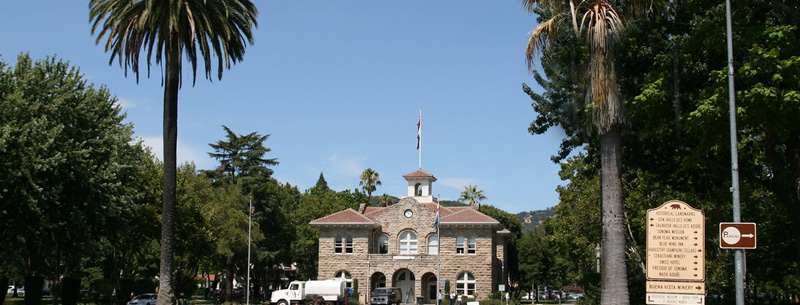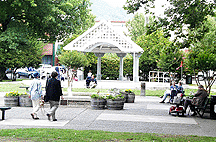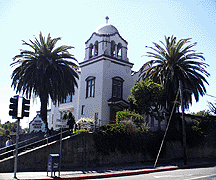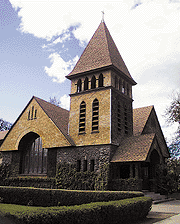Sonoma County Visitors Guide
Sonoma County is a region of spectacular attractions: fine wineries, dramatic coastlines, verdant hills, and charming inns. The area is also graced with bustling, vibrant cities and picturesque small hamlets.
Known as one of the finest wine-producing areas in the whole world, Sonoma County has hundreds of wineries that welcome visitors to sample their wares.
The county is usually portrayed as having six distinct regions. They include northern Sonoma, the Sonoma coast, the Russian River region, central Sonoma, southern Sonoma, and the Sonoma Valley region.
Northern Sonoma includes the towns of Cloverdale, Geyserville, Healdsburg and Windsor and the fine wine-producing regions of the Alexander Valley and the Dry Creek Valley.
The Russian River region includes the towns of Guerneville, Monte Rio, Duncans Mills, Sebastopol, Occidental, Graton, and Freestone. The region has several excellent wineries and is known for its recreational pleasures in and along the Russian River.
The Sonoma Coast is dotted with small hamlets such as Bodega Bay, Jenner, and The Sea Ranch. There are miles of coastal access in Sonoma Coast State Beach, which is actually several beaches under a collective banner. Fort Ross State Park is a former outpost for Russian fur hunters that has been renovated to its former state.
Central Sonoma is where the county seat, Santa Rosa, is located. Santa Rosa is a beautiful, exciting city that has kept the best features of its past and combined them with modern amenities. It is also home to the Luther Burbank Home and Gardens. Visitors will find excellent restaurants, entertainment and fine lodging in Santa Rosa.
Rohnert Park is just south of Santa Rosa and houses the Sonoma County Wine & Visitors Center, a necessary stop for anyone wanting to explore the area properly.
Southern Sonoma County includes the towns of Petaluma, Cotati, and Valley Ford. Petaluma has a turn-of-the-century downtown with iron front buildings that line the Petaluma River waterfront.
The Sonoma Valley, also known as the Valley of the Moon, contains dozens of wineries in the towns of Kenwood, Glen Ellen, and Sonoma. It’s also home to Jack London State Historic Park. Highlights include the Sonoma Mission, General Vallejo’s home and the historic Sonoma Plaza.
Synonymous with wine production in the United States, Sonoma County can be found north of San Francisco and just west of the Napa Valley, another famous U.S. wine region. While wine is at the forefront in Sonoma, there are numerous other activities to recommend this area as a travel destination. From the aquatic attractions of the Sonoma Coast to the balloon rides over the expanse of vineyards in the north and south parts of the county, Sonoma welcomes visitors year-round with a choice of accommodations, restaurants, and services that rivals larger California travel stops. The arts are strongly represented in this part of California as well, with numerous potters, painters and more calling Sonoma home, resulting in an impressive collection of galleries. Of course, a trip to this region is not complete without a visit to some of the many wineries and vineyards that dot the landscape.
Destinations in Sonoma County
Sonoma, CA Travel Guide
The Sonoma Valley is synonymous with wine production, which stems from decades of grape growing that has developed into more than 200 wineries that exist in the valley today. Between the balloon tours and wine tasting, visitors can enjoy the specialty shops and unique restaurants that are found in Sonoma. The arts are well represented in Sonoma, with a number of shops and boutiques showcasing the work of local artists. History can be found in the city as well at the Depot Park Museum, which is styled after an old train station and features a comprehensive look at the past in Sonoma and the surrounding area. For a more contemporary attraction, the Infineon Racetrack speeds into the future with motorbikes and stockcars vying for top positions during the race season.

Santa Rosa, CA
The largest city in the Sonoma Valley, Santa Rosa offers unparalleled culture, food, and entertainment. With more than 200 wineries, a number of golf courses, hot air ballooning and a number of award-winning spas all located near to Santa Rosa, this is a good base from which to take advantage of all that Sonoma County has to offer.
Check out our Santa Rosa Visitors Guide
Healdsburg Visitors Guide
Healdsburg could be considered the perfect wine country town – not too big, not too small – and situated right where the Alexander, Dry Creek, and Russian River Valleys, all prime wine regions, come together.

Located in the heart of northern California’s wine country, the city of Healdsburg is an ideal destination for wine enthusiasts, history buffs and adventure seekers. The Healdsburg area is home to nearly 100 wineries and vineyards, making winery tours and tastings a popular pastime.
The annual Barrel Tasting Weekend occurs every March, enabling visitors to enter the cellars of almost 100 wineries and sample wine directly from the barrel. For nine days in June, visitors are attracted to the Healdsburg Jazz Festival, which features performances by world-renowned jazz musicians in many area venues.
Healdsburg is also home to the Hand Fan Museum, the only one of its kind in the United States. On display are modern and antique hand fans that are elaborate in design. For the outdoor enthusiast, the nearby Lake Sonoma State Recreational Area offers boating, swimming, camping, and picnicking opportunities, as well as a fishery and interpretive center.
Sebastopol
The bustling town of Sebastopol is a great starting point to explore all of western Sonoma County. An attractive community of just under 7,500 souls, Sebastopol is situated at the crossroads of Highway 12 and Highway 116, also known as the Gravenstein Highway for the numerous apple orchards along its length.

Sebastopol has a wide variety of interesting retail shops, restaurants, automotive and other services, ample free parking and is famous for its concentration of antique shops and antique collectives. Outside the business district, many neighborhoods contain elegantly restored Victorian homes that were built in the late 1800s and early 1900s. Sebastopol’s Ragle Park encompasses 225 acres and is a favorite spot for bicycling, horseback riding and picnicking. It is also the site of the annual Gravenstein Apple Fair held in August.
In July, Sebastopol hosts the Teriyaki Chicken Barbecue and Japanese Bon Dancing Festival. The festival is held in the Enmanji Buddist Temple, south of town, which was originally brought over from Japan in 1933 for the Chicago World’s Fair. In springtime, the rich agricultural land surrounding Sebastopol is awash in delicate pink and white blossoms as thousands of acres of apple trees seem to bloom all at once. The Apple Blossom Festival in April commemorates this colorful event. It is held in Ives Memorial Park which has a duck pond, picnic areas, playground, and public swimming. In fall, area vineyards add their spectrum of golds, reds, russets, and yellows to the cyclical palette as the leaves turn. Fall is also a great time to pick a pumpkin from local farms. Blueberries, blackberries, and raspberries also are available directly from growers, as well as jams, preserves, and pies made from the succulent fruit. Farm Trails maps are available at the chambers of commerce and show how to find local farms. At year’s end, families can choose and cut their favorite variety of Christmas trees.
Sebastopol’s two highways lead visitors to the other nearby attractions of redwoods, the Russian River and the Sonoma Coast. Traveling west on Highway 12 brings one to the idyllic hamlet of Bodega, nestled between gentle hills with its church steeple appearing as an exclamation point. Just a couple miles farther on appears the Pacific Ocean at Bodega Bay, a coastal village that combines fishing, tourism, resorts, and recreation in its eclectic mix. North of Bodega Bay on Highway 1 is the 13 miles of Sonoma Coast State Beach, which is actually a series of beaches, some primitive, some with developed campsites. There are numerous access points in the park.
Regions of Sonoma County
Bodega Bay
Located on the Pacific Coast, 68 miles north of San Francisco, Bodega Bay facilitates a host of outdoor activities including some of the best whale watching in the United States. Bodega Bay is characterized by Bodega Head, a peninsula between the ocean and the bay and an ideal vantage point from which to observe whales. Whales migrate past this point twice a year, from January to February and April to May. The city is close to a number of parks and beaches, including Doran Regional Park, where camping, surfing, and body-boarding are popular activities. Visitors can also expect to find exceptional golfing, horseback riding, kayaking and diving opportunities nearby. In addition to Bodega Bay’s recreational prospects, a variety of gift shops and art galleries, such as the Branscomb Gallery, provide an interesting collection of items and a unique shopping experience.
Central Sonoma
Central Sonoma counts apple orchards and vineyards among its many sights and attractions, all of which are supported by accommodations and services that help contribute to a pleasant stay. Charles Schulz, the creator of the cartoon strip Peanuts, is celebrated at the Charles Schulz Museum in Santa Rosa, the county seat for Sonoma. The museum features a biography of Schulz as well as a research library dedicated to all things Snoopy. Another Central Sonoma town, Sebastopol has built a reputation for festivals and events that draw visitors from around the region, including the Apple Blossom Festival in April, an annual happening that displays some of the spirits that help make Sonoma a popular travel destination. Outdoor recreation is also catered to in the region with parks such as the Armstrong Redwoods State Reserve, Fort Ross State Historic Park and Austin Creek State Recreation Area in the area.
North Sonoma
North Sonoma is home to over 100 wineries and vineyards, giving visitors the opportunity to sample some of the best wine available in the United States. Healdsburg is one of the larger towns in North Sonoma and offers all the amenities to ensure a pleasant stay in California’s wine country.

Located at the point where the Dry Creek and Alexander Valleys converge, this area of Sonoma also features the Russian River, a community haven for fishing, swimming, canoeing and more. For nine days each June, guests to Healdsburg are regaled with music at the Healdsburg Jazz Festival, an event that presents talent hailing from the local area and around the globe. To explore the history of the area, visit the Healdsburg Museum and the Gould-Shaw House Museum.
Visitors interested in the history of Cloverdale and the region can visit the Cloverdale Historical Society Museum, located at 215 N. Cloverdale Blvd. The museum is housed in a historic home and contains both Native American and pioneer artifacts, as well as a recreated general store.
Check out our Cloverdale, CA Visitors Guide
Sonoma Coast
The coast of Sonoma County is one of the most beautiful and accessible sections of shoreline in California. Most of the 13 miles of coastline from Bodega Bay to Jenner, at the mouth of the Russian River, is part of the Sonoma Coast State Beaches and includes numerous campsites, hiking trails, and picnic areas.
The southernmost town on the Sonoma coast is the jewel-like village of Bodega Bay, home to approximately 300 commercial fishing boats. It is a popular visitor destination with numerous restaurants and lodging establishments. Highway 1 winds northward from Bodega Bay and passes through the hamlet of Jenner where the Russian River meets the coast. Although tiny, Jenner has restaurants and inns for travelers who can appreciate its quiet pace.
Twelve miles farther north is historic Fort Ross, a remote outpost settled in 1812 by fur trappers from Russia. The fort includes warehouses, a chapel, dwellings, a stockade, and workshops. Trappers lived at the fort for 40 years and almost completely wiped out the native sea otter population. The fort has been state property since 1906.
The Fort Ross visitor center and museum acquaint visitors with the history of the fort through slide displays and artifacts. There are also exhibits of Pomo Indian basketry. The Pomo were the original inhabitants of the area. Salt Point State Park offers another chance to enjoy the Sonoma Coast close up. The 3,500-acre park has several hiking trails that lead to old Pomo village sites, hidden coves, and a pygmy forest. The campground has both tent and RV campsites.
Northernmost on the Sonoma Coast is the planned development of Sea Ranch. A 10-mile stretch along the coast, Sea Ranch includes a restaurant and lodge for visitors and an 18-hole golf course. There are also six access trails through Sea Ranch property to the public beaches.
Sonoma Coast Highlights
- Bodega Bay – a picturesque fishing village with a sheltered harbor, sport fishing, recreational activities, bird watching, lodging, and restaurants.
- Fort Ross State Historic Park – a reconstructed outpost of Russian fur trappers founded in 1812. A visitor center, displays, historical reenactments. Hwy. 1, 12 mi. north of Jenner, (707) 847-3286.
- Salt Point State Park – camping, picnicking, hiking trails, ocean vistas. Hwy. 1, 20 miles north of Jenner, call (707) 847-3221 for information.
- Sonoma Coast State Beaches – 13 miles of public access beaches for beachcombing, hiking, camping and more. Hwy. 1, north of Bodega Bay, call (707) 875-3483 for information.
- Bodega Bay Chamber of Commerce – 850 Hwy. 1, Bodega Bay, CA. 94923, (707) 875-3422.
Russian River Region
The Russian River region is an area of small towns along the river of the same name, but also extending north and south of the river to include such towns as Cazadero, Occidental, and Sebastopol. The area was explored by Russian colonists from nearby Fort Ross between 1812 and 1841, which is how the river got its name. The Russians hunted seal and sea otter for their valuable pelts.
- Armstrong Redwoods State Reserve – a 750-acre stand of virgin redwoods, camping, hiking, horseback riding. Park Office and Ranger Station (707) 869-2015, Visitor Center (707) 869-2958.
- Gravenstein Apple Fair – local food, wines, bluegrass music and more, Ragle Ranch Park, Sebastopol, held in August. Call (707) 571-8288 for information.
- Russian River Jazz Festival – Sept. 11 and 12, 1999. Call (707) 869-3940 for information.
- Russian River – swimming, canoeing, camping, fishing
It is an area that has it all: wineries, resorts, redwood forests, campgrounds and all sorts of outdoor recreation possibilities. Canoeing, swimming, inner-tubing, fishing, rafting and sunbathing are all favorite pastimes along the river. Canoes can be rented in Forestville for a leisurely float down the river. It’s a great way to cool off from summer temperatures that can reach the 80s and 90s.
The largest town in the region is Guerneville. Settled in 1865 as a logging center, it is now primarily tied to the summer tourist industry and offers restaurants, lodging resorts, nightclubs and a variety of retail shops that cater to visitors. Guerneville is small enough that it pays to park the car and explore on foot. During warm weather, several restaurants offer outdoor seating. In June, Guerneville is host to the Russian River Blues Festival, and in September, the Russian River Jazz Festival. Both events are held at Johnson’s Beach and attract well-known artists and enthusiastic audiences. This year’s Jazz Festival includes such acts as Dr. John, Dee Dee Bridgewater, Poncho Sanchez, Branford Marsalis, Roy Hargrove, and others. In December Guerneville holds the Russian River Heritage Christmas, a Russian-style celebration with food, drinks, carriage rides and visits by Father Christmas. Golfers can tee off at the nearby Northwood Golf Course in Monte Rio, a nine-hole public course lined with redwoods. Fisherman can stop by King’s Sport & Tackle for the latest information on river conditions.
A scenic drive not to be missed is the lovely Bohemian Highway that connects Highway 116 and Highway 12. The road passes through the lovingly restored, but unpretentious town of Occidental. Once a lumber and railroad hub, the town now features several restaurants, a historic hotel, an elegant inn and various shops and galleries that calmly attend to the visitors that pass their way.
